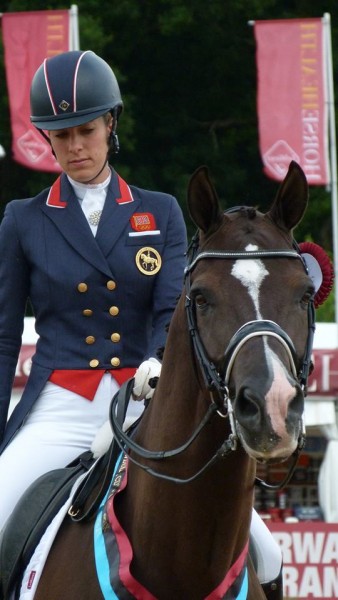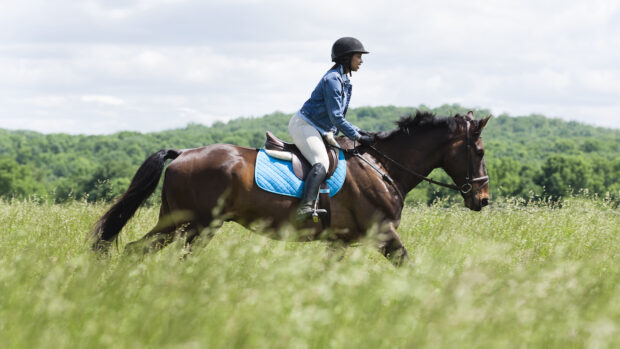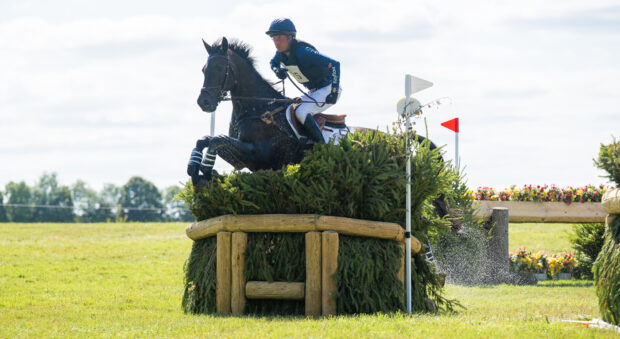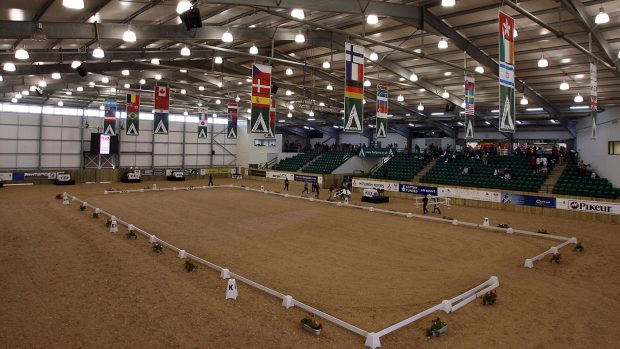Our lives were awash with elegance and poise throughout Hartpury’s Festival of Dressage held here from 8 -12 July.
The Festival welcomed the highest quality field across the board we’ve probably ever seen, fuelled by bumper entries overall and the week was studded an array of glittering performances.
I managed to catch some highlights, which for me included watching some really lovely and exciting young horses in the age classes. I was also one of the many who flocked to the mecca of the International arena (see above picture) on Friday and Sunday afternoon to watch Valegro’s first appearance at the Festival since 2012.
The banking around the edge forms a natural amphitheatre and but you could have heard a pin drop during the Grand Prix Special on the Sunday afternoon — such was the hush that rippled through the crowd when Charlotte Dujardin went to enter the arena.
I read a comment from Charlotte about the fact that she couldn’t believe that people were taking pictures of them wherever they went; so many people I spoke to were absolutely elated to have been able to watch them perform in the flesh. It was the first time I’ve ever seen him compete in real life, which is a bit odd really considering we see so much of him. I joked with Alan Davies (Valegro’s groom) beforehand that it’s like knowing Clark Kent when everyone else knows Superman — we reckoned his competition ear hat is the equivalent of Blueberry’s superman costume!
A matter of backwards and forwards
Of all the standout performances that I saw, there was an aspect that was common to all: the quality of their transitions. Yes, you need movement, suppleness and power, but to combine all of these things you need to be able to travel through the gears and proceed from movement to movement imperceptibly.
This sounds really obvious, but it is an incredibly difficult thing to achieve.
Using transitions in training helps the development of strength, balance, engagement, physical responsiveness and concentration in a horse; which are all of the things that then contribute to the improvement of the transitions themselves. And of course this doesn’t just refer to transitions between the gaits, it’s the tiny re-balancing aids you give, the half-halts, the collections, the extensions and everything in between in every single pace.
This is not a new idea, the powerhouses of equestrian sport have been advocating the use of frequent transitions within training for years, and in modern dressage possibly none more than Carl Hester who states that he will do literally hundreds of transitions within every training session, many of which we would barely be able to see.
Horses with lameness and/or soft tissue injuries such as proximal suspensory desmitis (PSD) in the hindlimbs often struggle with transitions as a symptom of their condition.
PSD is essentially a repetitive strain injury, and thus is particularly common in dressage horses where frequent collected work can inevitably start to leave its mark. This can result in a reduction in a horse’s ability to generate power from behind, be that when asking for a medium trot or collected canter for instance.
Other examples include untreated hock pain, which can manifest itself as a ‘hop’ from walk into trot or a bunny hop into canter, where the horse attempts to use its front end to pull itself forward and up through the gaits.
Downward transitions can be affected by lameness also, with many horses almost bracing with their front legs and feet rather than sitting with the hind quarters and taking the strain with the hind legs. Crookedness can also creep into transitions downward in a compromised horse.
Once a horse has been diagnosed and is under treatment for the cause of its lameness, transitions are one of the things we spend most time working on within a rehabilitation programme, allowing us to not only build strength but also address issues with the transitions themselves.
Our osteopath Liz is a big fan of using ‘small steps’ to teach the horse how to be straight and hold their rhythm in downward transitions again, allowing a progressive change of gait. This technique will also encourage a more prevalent stance phase in each stride, essentially encouraging each hind foot to be in contact with the ground for longer and thus start to generate more power.
As the horse progresses in its work, transitions also help to increase the intensity of a session without having to go through more limb cycles, so you get maximum benefit from your training session.
Meeting an inspiration
Equal to the FEI CDI and Premier League classes at the Festival of Dressage was the FEI CPEDI3* para-dressage competition that ran from Wednesday to Friday that week.
I noticed that fellow H&H blogger Suzannah Hext’s lorry was parked outside of our barn and saw her one day just outside of it. I’ve been reading Suzannah’s blogs from the outset, so went up and introduced myself as a bit of fan!
What a charming, lovely person she is. I joked with her about how excited I was to have met someone famous, but I guess what I really meant was to meet someone who is such an inspiration to so many. Her story is truly remarkable and it was great to see her competing here as her first International competition.
For any of you who haven’t yet read her blogs – they really are worth a look! If you want an account of human endeavour and achievement, this is the girl for you.
Fizz




